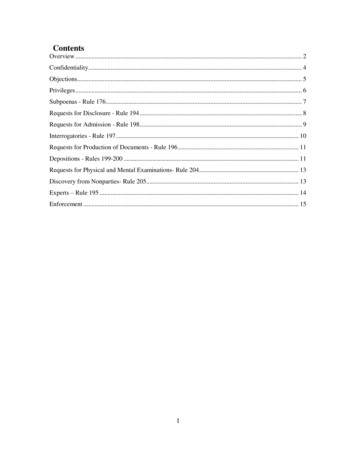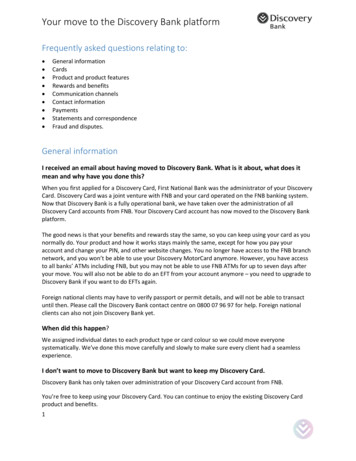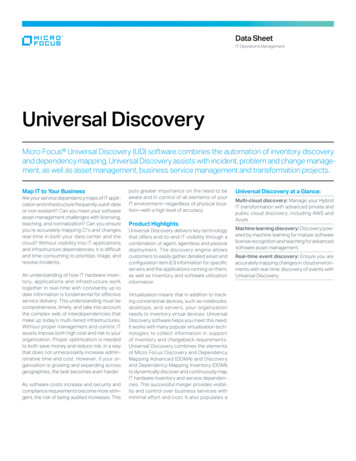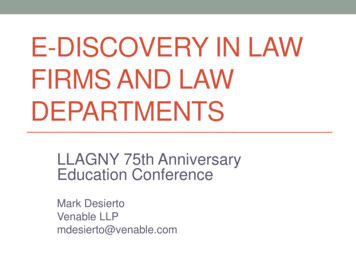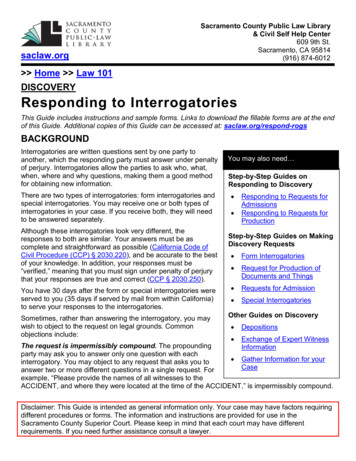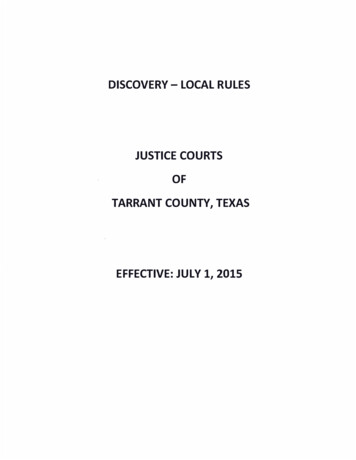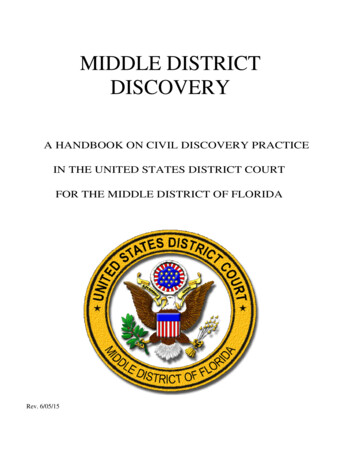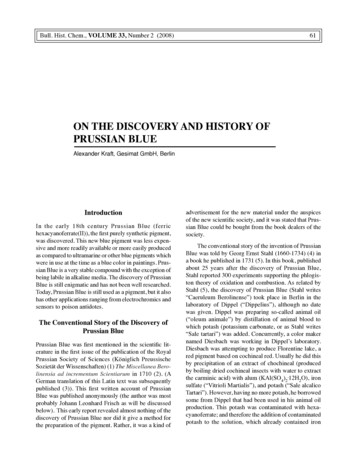
Transcription
Bull. Hist. Chem., VOLUME 33, Number 2 (2008)61ON THE DISCOVERY AND HISTORY OFPRUSSIAN BLUEAlexander Kraft, Gesimat GmbH, BerlinIntroductionIn the early 18th century Prussian Blue (ferrichexacyanoferrate(II)), the first purely synthetic pigment,was discovered. This new blue pigment was less expensive and more readily available or more easily producedas compared to ultramarine or other blue pigments whichwere in use at the time as a blue color in paintings. Prussian Blue is a very stable compound with the exception ofbeing labile in alkaline media. The discovery of PrussianBlue is still enigmatic and has not been well researched.Today, Prussian Blue is still used as a pigment, but it alsohas other applications ranging from electrochromics andsensors to poison antidotes.The Conventional Story of the Discovery ofPrussian BluePrussian Blue was first mentioned in the scientific literature in the first issue of the publication of the RoyalPrussian Society of Sciences (Königlich PreussischeSozietät der Wissenschaften) (1) The Miscellanea Berolinensia ad incrementum Scientiarum in 1710 (2). (AGerman translation of this Latin text was subsequentlypublished (3)). This first written account of PrussianBlue was published anonymously (the author was mostprobably Johann Leonhard Frisch as will be discussedbelow). This early report revealed almost nothing of thediscovery of Prussian Blue nor did it give a method forthe preparation of the pigment. Rather, it was a kind ofadvertisement for the new material under the auspicesof the new scientific society, and it was stated that Prussian Blue could be bought from the book dealers of thesociety.The conventional story of the invention of PrussianBlue was told by Georg Ernst Stahl (1660-1734) (4) ina book he published in 1731 (5). In this book, publishedabout 25 years after the discovery of Prussian Blue,Stahl reported 300 experiments supporting the phlogiston theory of oxidation and combustion. As related byStahl (5), the discovery of Prussian Blue (Stahl writes“Caeruleum Berolinense”) took place in Berlin in thelaboratory of Dippel (“Dippelius”), although no datewas given. Dippel was preparing so-called animal oil(“oleum animale”) by distillation of animal blood towhich potash (potassium carbonate, or as Stahl writes“Sale tartari”) was added. Concurrently, a color makernamed Diesbach was working in Dippel’s laboratory.Diesbach was attempting to produce Florentine lake, ared pigment based on cochineal red. Usually he did thisby precipitation of an extract of chochineal (producedby boiling dried cochineal insects with water to extractthe carminic acid) with alum (KAl(SO4)2.12H2O), ironsulfate (“Vitrioli Martialis”), and potash (“Sale alcalicoTartari”). However, having no more potash, he borrowedsome from Dippel that had been used in his animal oilproduction. This potash was contaminated with hexacyanoferrate; and therefore the addition of contaminatedpotash to the solution, which already contained iron
Bull. Hist. Chem., VOLUME 33, Number 2 (2008)62sulfate, resulted in a blue precipitate, the Prussian Blue,instead of the expected red product.To date, these two reports (2, 5) have been considered to be the only sources of information on the veryearly history of Prussian Blue. However, there existsa neglected source of information on the first years ofPrussian Blue: the correspondence of Leibniz.with three responses from Leibniz to Frisch. Thirteenof these letters from Frisch mention the new pigmentPrussian Blue; and in five letters Diesbach, one of twoinventors indicated by Stahl (5), is mentioned (Frischwrites his name “Diessbach” or “Dieszbach”). Diesbachis mentioned in direct connection with the new blue color.The letters do not state the first name of Diesbach, thestory of the invention of Prussian Blue, or the names ofthe inventors.Johann Leonhard Frisch had been living in Berlinsince 1698. He taught at the Berlin Gymnasium located inthe former Grey Monastery of the Franciscans. Frisch hadbeen a member of the Berlin Society of Sciences since1706 (8). In his first letter to Leibniz in which PrussianBlue is mentioned, written on March 31, 1708, Frischinformed Leibniz that he had already earned some moneywith his blue color. In the second letter that mentionsPrussian Blue, dated April 28, 1708, Frisch stated thathe had made the color better than the original inventorhad done and that the production process was now lessexpensive.Figure. First page of the first publication on PrussianBlue from the Miscellanea Berolinensia ad incrementumScientiarum (2)The Correspondence of LeibnizGottfried Wilhelm Leibniz corresponded with an enormous network of people scattered throughout Europe.This correspondence was conducted in several languages,mainly in Latin, French, and German (6).A major additional source on the very early historyof Prussian Blue is a set of letters sent from Johann Leonhard Frisch (1666-1743) in Berlin to Gottfried WilhelmLeibniz in Hannover (7), which were first published ina book in 1896 (8). This book contained 37 letters fromFrisch to Leibniz between the end of 1706 and September19, 1716 (Leibniz died on November 14, 1716), togetherIn a much later letter of September 14, 1715, however, Frisch informed Leibniz that he himself was theinventor. This statement may have been a reaction to anassertion made to Leibnitz by Diesbach’s father-in-lawMüller (at this time residing in Vienna), who claimed tobe the inventor of Prussian Blue. This letter also clarified that the secret of the production of Prussian Bluewas strongly protected and that at this time (in 1715), atleast in Berlin, only Diesbach and Frisch knew how tomake Prussian Blue. (The name of Dippel, the secondpossible original inventor, did not appear in the lettersfrom Frisch to Leibniz).The name Prussian Blue (“Preussisch-blau”) is usedin one letter dated August 25, 1709 and the name BerlinBlue (“Berlinisch Blau” or “Berlin Blau”) in two laterletters (from November 9, 1709 and September 2, 1712).However, in most letters, it was simply called the bluecolor (“blaue Farb(e)”). The name of Diesbach appearsfor the first time in a letter from September 28, 1709,which stated that Diesbach had printed an informationalsheet for painters about the blue color.Diesbach seems to have been active in alchemical studies as well. Indications of these investigationsappeared in two letters (from September 28, 1709 andundated, but perhaps from about spring 1710).In a letter of November 9, 1709, Frisch sent Leibniza Latin text about the blue color. In another letter fromJanuary 30, 1710, he told Leibniz that the text “notitia
Bull. Hist. Chem., VOLUME 33, Number 2 (2008)caerulei Berolinensis” that Leibniz sent back had beenadded to the texts for the Miscellanea. These two lettersmost probably refer to the first publication on PrussianBlue (2). It appears that Frisch was the author of thispublication which had been published anonymously.The profitable business of selling Prussian Blue wascause to protect the secret of its preparation. In severalletters to Leibniz Frisch revealed details of his commercial success with selling Prussian Blue. At that time,Diesbach was producing Prussian Blue while Frisch wasselling it, at least outside Berlin. In a letter dated October29, 1712, Frisch wrote that he was not able to satisfy thedemand for Prussian Blue. Soon imitation Prussian Blue,perhaps indigo blue being sold as Prussian Blue, appearedon the market (letter from August 25, 1709).Because of the large amount of money Frisch earnedby selling Prussian Blue, he was able to buy land outsidethe Spandau Gate of Berlin. He used this land for hisbotanical experiments with mulberry trees and otherplants, according to a letter from July 26, 1715. As anexample of his sales, this letter indicated that he sold 100pounds of Prussian Blue in Paris for 30 thaler per poundin the year 1714.Sales of Prussian Blue that were explicitly describedincluded those to Wolffenbüttel (9) (letters from September 28, 1709 and November 9, 1709), in Paris (lettersfrom July 26, 1715 and September 19, 1716) and in St.Petersburg (letter from September 19, 1716). In the last ofthese letters, Frisch reported to Leibniz that in Paris twofactories that produced ultramarine (10) (“Outremer”)had been closed because of the large amounts of PrussianBlue he delivered to Paris.Leibniz was obviously somewhat involved in thesale of Prussian Blue or at least was active in informing potential customers about this new pigment. Frischwrote Leibniz in a letter dated September 2, 1712, thatBernoulli (a Swiss mathematician from Basel who corresponded with Leibniz, see below) could purchase hishalf pound of Prussian Blue in Leipzig from Gleditschfor 15 thaler.The only use of Prussian Blue reported in theseletters is as a blue pigment for painters. The letter ofSeptember 28, 1709 reported that (Christoph Joseph)Werner (11), a Swiss painter in Berlin, had used the bluecolor for a long time and that he had sent it to other painters in quantity (8). Recently, Bartoll et al. (12) showedin an investigation of paintings from the collection ofKing Friedrich II of Prussia (the grandson of Friedrich I)63that Prussian Blue can be found in paintings from Watteau that were painted in Paris between 1710 and 1712.Prussian Blue was also detected in paintings producedin Berlin by Antoine Pesne and others, the earliest beingfrom 1710 (12). However, the earliest painting in whichPrussian Blue was identified by Bartoll and colleagueswas the “Entombment of Christ” by the Dutch painterPieter van der Werff (1666-1720), which was paintedin 1709 in the Netherlands . As shown below, duringthis time Dippel lived in the Netherlands and was alsoproducing Prussian Blue.In addition to the Frisch letters, other correspondence of Leibniz referred to Prussian Blue. In his correspondence with Johann Bernoulli (1667-1748) betweenDecember, 1710 and December, 1711 (13), Prussian Bluewas discussed. Another example is a letter from Paris(dated August 17, 1714), in which the writer Haspergtold Leibniz (14) that Homberg (15) wanted Leibniz todescribe the procedure for production of Prussian Blue.This letter mentioned that Leibniz had previously writtento Homberg about Prussian Blue. Hasperg also stated inthis letter that he and Homberg did not know the identityof the inventor. He further told Leibniz that a Germanin the Netherlands with the name “Dipelius” was alsopreparing the blue color and that he had a sample ofthis color, which was not as beautiful as the blue colorfrom Berlin. Thus, it is clear that during his stay in theNetherlands, Dippel, the second inventor indicated byStahl (5), was also producing Prussian Blue, but of aninferior quality.Dippel in Berlin and the NetherlandsAccording to Stahl (5), the invention of Prussian Bluetook place in the laboratory of Johann Konrad Dippel(1673-1734) in Berlin. Documents from the periodshowed Dippel’s name, variously written as Dippelio,Dipelius, or Dippelius. He was a theologian, alchemist,and physician. Many of his mostly theological bookswere printed under the pseudonym Christianus Democritus. (Further information on Dippel’s life can be foundin Ref. 16-18) (19).Around 1700, after some years of theologicaldispute, Dippel became interested in alchemy. First, heconcentrated on attempts to transmute base metals intogold and later turned to finding a universal medicine. Hethought that a substance which he called animal oil, produced by destructive distillation of animal blood, wouldbe this universal medicine. Aynsley and Campbell wroteof Dippel s animal oil (18):
64A glance at the list of principal constituents is enoughto convince one of the heroic nature of the cure.In the autumn of 1704, he moved to Berlin, invitedby Count August David zu Sayn-Wittgenstein (16631735), who was one of the leading figures at the courtof King Friedrich I. Here he rented a palatial house forhis alchemy studies. Johann Georg Rosenbach, also aradical pietist, was living in this house and took part inDippel’s experiments.In the early 18th century, Berlin was a good environment for alchemists who claimed to be able to convertcommon metals into gold. However, if they were notable to deliver gold, it could become dangerous. Of thealchemists who were active at this time in Berlin, JohannFriedrich Böttger (1682-1719) and Domenico EmanueleCaetano (?-1709) are the most famous. In 1701 Böttgerfled from Berlin to Saxony, where he was later involvedin the invention of European porcelain. Caetano arrivedin Berlin in 1705. Dippel participated in the first tests ofthe abilities of Caetano as an alchemist. In 1709 Caetanowas hanged in Küstrin (20). Other alchemists active inBerlin at that time, mentioned by Frisch in his letters toLeibniz (8), included Felmi (or Felmy or Filmey) andMeder.Nothing specific is known about the alchemisticwork of Dippel in Berlin. In early 1707 Dippel wasarrested and held for about a week in the Hausvogteyprison at the request of the Swedish ambassador. Dippelhad published a new theological book, which containedsome harsh criticism of the Swedish Lutheran church.He was released on bail provided by Count Wittgensteinand soon fled from Berlin to the Netherlands. Living inMaarsen between Utrecht and Amsterdam, he workedas a physician for the next few years. From the letterof Hasperg to Leibniz, written in 1714 (14), it can beconcluded that Dippel was also producing Prussian Blueduring his stay in the Netherlands. He left the Netherlandsin 1714 (21).Since Dippel arrived in Berlin in the autumn of 1704and left Berlin early in the year 1707, the invention ofPrussian Blue most probably took place in 1705 or 1706.In a handwritten Berlin chronicle from approximately1730 (22), the invention of Prussian Blue by the Swiss“Joh. Jacob Diesbach” is recorded for the year 1706. Thisdate is the most probable year that is based on originalsources.Bull. Hist. Chem., VOLUME 33, Number 2 (2008)The Secret is OutDespite the efforts to conceal the production method ofPrussian Blue, it remained secret for only about 20 years.In 1724 John Woodward published a procedure for theproduction of this color in the Philosophical Transactions of the Royal Society in London (23), and it wasimmediately followed by an account of some detailedexperimental work on Prussian Blue by John Brown (24)in the same issue. The Woodward paper was based on aletter sent to him from Germany that disclosed the heretofore secret procedure, but Woodward did not publishthe name of the author. Brown, a Fellow of the RoyalSociety since 1721, stated in his paper that (24):Dr. Woodward having lately communicated a paper(which he receiv’d from another hand) to this Society,containing a Process for making the Prussian Blue,I was willing to go thro’ it exactly, according to theproportions there prescrib’d.Obviously, John Woodward (1657-1728) (25), a physician, naturalist, and geologist, had asked the chemistBrown (?-1735) to perform some preliminary experiments to verify the contents of the paper he had receivedfrom Germany. In January / February, 1724 these twopapers (23, 24) were communicated to the Royal Societyand printed in the Transactions.In his experiments Brown (24) not only followedthe method communicated by Woodward, but also varied the procedure by precipitation of alternative metalhexacyanoferrate compounds, using silver, mercury, copper, bismuth (denoted as “Tin-Glass”), and lead insteadof the iron used for preparing Prussian Blue. Thus, heperformed the first documented research on the so-calledPrussian Blue analogs, which continue to represent a major research field today. However, these experiments didnot result in the beautiful blue precipitate that iron hexacyanoferrate gave. He also showed that in the calcinationstep, animal blood could be replaced by flesh (“beef”)during the production process of Prussian Blue.From whom Woodward received the informationfor making Prussian Blue is not clear and remains opento further investigation. Shortly after the two publications of Woodward and Brown, other people repeatedthe experiments and came to additional new conclusions. Notably Etienne-Francois Geoffroy (1672-1731)(26) in 1725 communicated to the French chemists thesecret of the Prussian Blue production and publishedsome new information (27-29). He found that PrussianBlue production could be achieved from other parts of
Bull. Hist. Chem., VOLUME 33, Number 2 (2008)animals such as horn, hair, skin, or hoof, in addition todried blood and flesh (28).With the secret of its preparation revealed, production of Prussian Blue began throughout Europe. Oftenit was sold under different names such as Paris Blue orMilori Blue, usually named after the production location, the owner of the facility, or based on an advertisingidea (30). The production technology changed greatlyover time. Asai analyzed about 100 methods publishedbetween 1724 and 1904 and documented the increasingimprovements in product quality that resulted (30).Prussian Blue was not only used as a pigment forpainters but it was soon applied to the dyeing of textiles,following the work of P. J. Macquer (1718-1784) (31)conducted in 1749 toward this goal (32). Prussian Bluewas also used for blueing textiles, is still used as a pigment today, and sold under the commercial name IronBlue.The Continuing Story of Prussian BlueStarting in 1724 and continuing for about 250 years,chemists tried to define the composition, stoichiometry,and structure for Prussian Blue. Eminent scientists suchas Priestley, Scheele, Berthollet, Gay-Lussac, and Berzelius were among the researchers in the field (33). In1782 Scheele discovered hydrogen cyanide by heatingPrussian Blue with diluted sulfuric acid (34), and in1811 Gay-Lussac’s determination of the composition ofhydrogen cyanide (35) led to the conclusion that PrussianBlue contained cyanide. Because of the lack of modernanalytical methods, the details of the crystal structureand even of the analytical composition of Prussian Bluewere for a long time only partially resolved.The first structural hypothesis for Prussian Blue waspresented by Keggin and Miles with the help of X-raypowder patterns (36). Finally, in the 1970s Ludi et al.(37) published a detailed structure and confirmed thecomposition as Fe4[Fe(CN)6]3·xH2O (x 14-16), whichis now accepted as correct.The use of Prussian Blue as a painter’s pigment inthe early 18th century and as a dye for coloring textileswas followed by other uses. An important example isthe cyanotype or blueprint process invented by Herschelin 1842 (38). This was a commercially successful photocopying process in use from 1843 until the early 1940s.Prussian Blue is also used in analytical applications, e.g.,spot tests in the classical analytical chemistry of iron.65Prussian Blue has a very high affinity for thalliumand cesium ions (39). Therefore, people who have become internally contaminated with radioactive thallium,nonradioactive thallium, or radioactive cesium can betreated by orally administered Prussian Blue, which trapsthallium and/or cesium in the gut and thereby increasesfecal excretion. Thus, the biological half-life of thalliumand cesium is significantly reduced after capture therapywith Prussian Blue (39).In 1978, Neff published a short notice in which hedescribed the electrochemical deposition of thin films ofPrussian Blue from aqueous precursor solutions onto conducting substrates. These films can be switched reversibly by electrochemical means between different coloredoxidation states (40) in a process called electrochromism.Especially interesting for practical use is the alternationbetween colorless and blue oxidation states. One possiblenew application is the construction of so-called smartwindows which can reversibly change their transmissionof light between very high and low values (41).Another technically interesting property of PrussianBlue is its ability to catalyze the reduction of hydrogenperoxide and molecular oxygen (42). Current investigation is underway to employ this effect for the constructionof sensors for clinical, environmental, and food analysis(43). Prussian Blue also holds some potential as an activematerial in modern batteries (44) or as an electrocatalystfor fuel cells (45).ConclusionsPrussian Blue was discovered by Diesbach and Dippelbetween 1704 and 1707, but most probably in 1706 inBerlin. Written evidence indicates that Prussian Bluewas produced at least between 1708 and 1716 in Berlinby Diesbach and Frisch, and that it was mainly sold byFrisch. Dippel also produced Prussian Blue during hisstay in the Netherlands until 1714. Diesbach and Frischtried to protect the secret of Prussian Blue productionbecause of its great commercial success. Once the secretwas given away in 1724, production and research startedin various European countries. The use of Prussian Blueas a blue pigment still continues today. Although Prussian Blue has been known in the scientific communityfor 285 years and has attracted much research ever since,new and promising areas of application are still beingexplored today.
Bull. Hist. Chem., VOLUME 33, Number 2 (2008)66REFERENCES AND NOTES1.The Royal Prussian Society of Sciences was founded in1700 in Berlin under the name Electoral BrandenburgSociety of Sciences. Gottfried Wilhelm Leibniz (16461716), residing from 1676 in Hannover who initiatedthe founding of this society, was appointed president,a post he held until his death. One year after the founding of the Society Elector Friedrich III. of Brandenburgcrowned himself in Königsberg (the modern Kaliningadin Russia) the first king in Prussia (Friedrich I.), startingthe short history of the Kingdom of Prussia (1701-1918).Therefore, the name of the Society of Sciences changedto Royal Prussian Society of Sciences. In 1744 it wasrenamed the Royal Academy of Sciences.2. (J. L. Frisch ?), “Notitia Caerulei Berolinensis NuperInventi,” Miscellanea Berolinensia ad incrementumScientiarum, 1710, 1, 377-378.3. Anon., “Nachricht von dem vor kurzem erfundenenBerlinerblau,” Physicalische und Medicinische Abhandlungen der Koeniglichen Academie der Wissenschaftenzu Berlin, 1781, 1, 95-97.4. Stahl, a physician and chemist, was professor of medicineat the university in Halle from 1694 to 1715. Then hemoved to Berlin to become appointed physician to KingFriedrich Wilhelm I, the son of King Friedrich I. Stahldied in Berlin.5. G. E. Stahl, Experimenta, Observationes, Animadversiones, CCC Numero Chymicae et Physicae, AmbrosiusHaude, Berlin, 1731, 280-283.6. Many of Leibniz’ letters and those sent to him are preserved (about 15,000 letters to and from about 1,100correspondents) and part of these preserved letters werealready been published in the 19th century. Others arestill waiting to be published. Since 2007, the correspondence of Leibniz is registered in the UNESCO worlddocumentary heritage Memory of the World. In 1901,work was started on publishing a complete critical edition of Leibniz’s writings and correspondence. Sincethen the Academy Edition (“Akademie-Ausgabe”) hasbeen publishing the different series of Leibniz’s writingsand correspondence, a task that will continue for an estimated 30 years to come. This Academy edition is beingprepared today by four research centers (in Hannover,Münster, Potsdam, and Berlin) of two local Germanscience academies (Göttingen Academy of Sciences andBerlin-Brandenburg Academy of Sciences).7. Hannover was the residence of the Duke of Braunschweig-Lüneburg. Leibniz worked as Privy Counselor ofJustice for the Duke.8. L. H. Fischer, Ed., Joh. Leonh. Frisch’s Briefwechselmit G. W. Leibniz, Georg Olms Verlag, Hildesheim, NewYork, 1976 (reprint of the book from 1896).9. The town of Wolfenbüttel was the residence of AntonUlrich Duke of Braunschweig-Wolfenbüttel. Part of histime Leibniz worked for him as a librarian.10. At this time, for preparing the very expensive natural11.12.13.14.15.16.17.18.19.20.21.22.pigment ultramarine (Na8-10Al6Si6O24S2-4), the minerallapis lazuli was imported to Europe from Asia by sea(ultramarine literally means ‘beyond the sea’) and furtherground and processed in local factories. A process for theproduction of synthetic ultramarine was discovered in1826.His father was Joseph Werner (1636-1710), first directorof the Academy of Arts in Berlin from 1696, who returnedto Switzerland in 1706.J. Bartoll, B. Jackisch, M. Most, E. Wenders de Calisse,and C. M. Vogtherr, “Early prussian blue: blue and greenpigments in the paintings by Watteau, Lancret and Paterin the collection of Frederick II of Prussia,” Technè, 2007,25, 39-46.C. I. Gerhardt, Ed., Leibnizens mathematische Schriften,Part 1, Ch. 3, “Briefwechsel zwischen Leibniz, JacobBernoulli, Johann Bernoulli und Nicolaus Bernoulli,”Verlag H. W. Schmidt, Halle, 1855, 858-878.G. W. Leibniz, Sämtliche Schriften und Briefe, Reihe I,Allgemeiner, politischer und historischer Briefwechsel,Transkriptionen November 1703-November 1716, n 391,471-472. (version from 14.8.2007)Wilhelm (Guillaume) Homberg (1652-1715) was a German scientist born in Batavia (the modern Jakarta inIndonesia) and living in France from 1682.J. C. Adelung, “Johann Conrad Dippel, ein indifferentistischer Schwärmer,” in Geschichte der menschlichenNarrheit, Part 1, Weygand, Leipzig, 1785, 314-347.K. Buchner, “Johann Konrad Dippel,” in Friedrich vonRaumer, Ed., Historisches Taschenbuch, 3. Folge, 9.Jahrgang, F.A. Brockhaus, Leipzig, 1858, 207-355.E. E. Aynsley and W. A. Campbell, “Johann Konrad Dippel, 1673-1734,” Med. Hist., 1962, 6, 281-286.Dippel was born at Frankenstein castle near Darmstadt inHesse (Germany) in 1673. His family lived in a nearbyvillage and fled during a French raid in the Franco-DutchWar (1672-1678) to the castle Frankenstein. He studiedtheology in Giessen (Hesse, Germany) from 1689 to1693 and in Strasbourg (Alsace, France) from 16951696. In Strasbourg he became a radical pietist. Pietismwas a movement within Lutheranism at that time. FromStrasbourg he moved back to Hesse in 1696.This is now Kostrzyn in Poland, a town with a big Prussian fortress and prison at that time.He had to leave the Netherlands again, because of atheological book which contained religious opinions thatwere not tolerable even in the Netherlands. Dippel nextmoved to Altona, at that time a Danish town. Today it ispart of Hamburg, Germany. From 1719 until 1726 he wasimprisoned on the Danish island of Bornholm. In 1726he moved to Sweden but was forced to leave in 1728. Hespent the last years of his life near castle Berleburg byCasimir von Wittgenstein, not far from the border to hishome country Hesse.J. E. Berger, Kernn aller Fridrichs-Städtischen Begebenheiten, manuscript Berlin State Library - Prussian CulturalHeritage, Ms. Bor. Quart. 124, Berlin, ca 1730, 26.
Bull. Hist. Chem., VOLUME 33, Number 2 (2008)23. J. Woodward, “Praeparatio Caerulei Prussiaci ex Germania missa ad Johannem Woodward,“ Philos. Trans.R. Soc., 1724, 33, 15-17.24. J. Brown, “Observations and experiments upon theforegoing preparation,” Philos. Trans. R. Soc., 1724, 33,17-24.25. John Woodward was appointed professor of medicine inGresham College in London.26. Etienne-Francois Geoffroy was a French physician andchemist best known for his affinity tables.27. Anon., “Sur le Bleu de Prusse,” Hist. Acad. R. Sci., 1725,33-38.28. É.-F. Geoffroy, “Observations sur la Preparation de Bleude Prusse ou Bleu de Berlin,” Mém. Acad. R. Sci., 1725,153–172.29. E.-F. Geoffroy, “Nouvelle Observations sur la Preparation de Bleu de Prusse,” Mém. Acad. R. Sci., 1725,220–237.30. C. Asai, “‘Handmade’ Berlinerblau,” ZKK Zeitschrift fürKunsttechnologie und Konservierung, 2004, 18, 268292.31. Pierre Joseph Macquer, a French chemist, was the authorof the first chemical dictionary (1766).32. P. J. Macquer, “Mémoire sur une nouvelle espèce deteinture bleue, dans laquelle il n’entre ni pastel ni indigo,”Mém. Acad. R. Sci., 1749, 255-264.33. L. J. M. Coleby, “A History of Prussian Blue,” Ann. Sci.,1939, 4, 206-211.34. C. W. Scheele, “Über die färbende Materie in Berlinerblau,” Neue Schwed. Akadem. Abhandl., 1782, 3, 256266.35. J. L. Gay-Lussac, “Recherches sur l‘acide prussique,”Ann. Chim., 1815, 95, 136-231.36. J. F. Keggin and F. D. Miles, “Structures and Formulaeof the Prussian Blues and Related Compounds,” Nature,1936, 137, 577-578.37. H. J. Buser, D. Schwarzenbach, W. Petter and A. Ludi,“The Crystal Structure of Prussian Blue: Fe4[Fe(CN)6]3xH2O,” Inorg. Chem., 1977, 16, 2704-2710.38. M. Ware, Cyanotype : The History, Science and Art ofPhotographic Printing in Prussian Blue, National Mu-6739.40.41.42.43.44.45.seum of Photography, Film and Television, Bradford, UK,1999.D. F. Thompson and E. D. Callen, “Soluble or InsolublePrussian Blue for Radiocesium and Thallium Poisoning?”Ann. Pharmacother., 2004, 38, 1509-1514.V. D. Neff, “Electrochemical Oxidation and Reductionof Thin Films of Prussian Blue,“ J. Electrochem. Soc.,1978, 125, 886-887.A. Kraft, M. Rottmann and K.-H. Heckner, “Largearea Electrochromic Glazing with Ion-conducting PVBInterlayer and two Complementary ElectrodepositedElectrochromic Layers,” Sol. Energy Mater. Sol. Cells,2006, 90, 469-476.K. Itaya, N. Shoji, and I. Uchida, “Catalysis of the Reduction of Molecular Oxygen to Water at Prussian BlueModified Electrodes,“ J. Am. Chem. Soc., 1984, 106,3423-3429.F. Ricci and G. Paleschi, “Sensor and Biosensor Preparation, Optimisation and Applications of Prussian BlueModified Electrodes,” Biosens. Bioelectron., 2005, 21,389-407.M. Jayalakshmi and F. Scholz, “Charge-discharge Characteristics of a Solid State Prussian Blue Secondary Cell,”J. Power Sources, 2000, 87, 212-217.G. Selvarani, S. K. Prashant, A. K. Sahu, P. Sridhar, S.Pitchumani, and A. K. Shukla, “A Direct BorohydrideFuel Cell Employing Prussian Blue as Mediated Electron-transfer Hydrogen Peroxide Reduction Catalyst,”J. Power Sources, 2008, 178, 86-91.ABOUT THE AUTHORAlexander Kraft, Ph.D. in Physical Chemistry (semicondu
a neglected source of information on the first years of Prussian Blue: the correspondence of Leibniz. The Correspondence of Leibniz Gottfried Wilhelm Leibniz corresponded with an enor-mous network of people scattered throughout Europe. This correspondence was conducted in several languages, mainly in Latin, French, and German (6).



